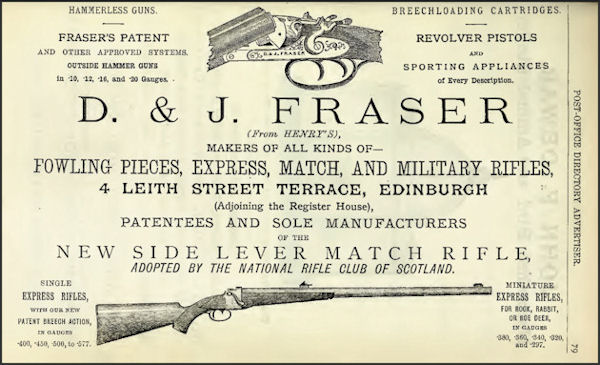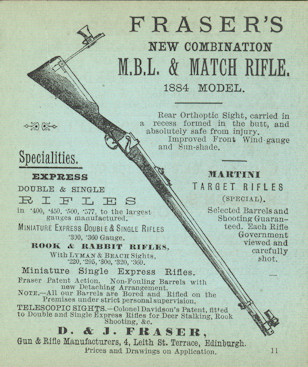You are here: Home > Firearms > Gunmakers > Daniel Fraser
Written by: David Minshall
Daniel Fraser was born c1848, the son of Lauchlan and Mary (nee Mackintosh) Fraser. Lauchlan was a coach body maker, an occupation also followed by Daniel’s older brother John. Daniel served an apprenticeship with the Edinburgh gunmaker Alexander Henry.
Around 1873 Daniel set up his own business in Edinburgh. Initially at Greenside Place, within a year he moved to Leith Walk where he remained until 1878. At this time he went into business with his brother John, forming D. & J. Fraser and moving the business to new premises on Leith Street Terrace. Obviously proud of his apprenticeship with Alexander Henry (and aware of its marketing potential), an 1882 advert for the gunmakers carries ‘(From HENRY’S)’ beneath the name ‘D. & J. Fraser’.
c1889 Daniel and John parted company, each continuing to trade separately as gunmakers in Edinburgh. While Daniel’s business (Daniel Fraser & Company (later Limited)) continued to operate into the 1930s, John Fraser appears to have ceased trading c1898.
Target Rifles
Relationships with Alexander Henry appear to have remained amicable for in 1877 he and Daniel Fraser were granted Patent No. 1559 for a unique rifle; the Henry-Fraser Two Position Rifle.
Daniel was granted his own patent (No. 5403) in 1880 for a falling block design. A match rifle using this action was quickly adopted by the National Rifle Club of Scotland; six of the Scottish Eight competing for the Elcho Shield used the Fraser rifle in 1881. The Glasgow Herald reported on the rifle that year.
Reportedly and in its early form the barrel had nine grooves .005 deep, with a spiral of one turn in 20 inches. The cartridge-shell was of solid drawn brass, taking a charge of 85 grains, special lubrication and bullet 550 grains weight.


The NRA in their Annual Rifle Meetings at Wimbledon held competitions for military breech loaders. These encouraged gunmakers to develop rifles conforming to the definitions of the class for a military rifle, including weight, length, trigger pull and sights, although not necessarily of Government pattern.

In 1884 D. & J. Fraser introduced a combined Military Breech Loader and Match Rifle. This rifle is illustrated to the right (this D. & J. Fraser advert is from the National Rifle Association 1885 Wimbledon Meeting programme). The rearsight for match rifle shooting was carried in a recess formed in the butt, where it was protected when not in use. It was intended for use in the back position. To adapt the rifle for match shooting a cover was removed from the stock to access the rearsight, and a detachable wind-gauge foresight was placed over the front or military sight. This found popularity with those unwilling (or unable) to invest in two separate rifles; one for Military Breech Loader and one for Match Rifle competitions.
Ammunition
Whilst researching D. & J. Fraser I came across reference to hand loading, powder used and patching bullets.
See: ‘The Perils of Hand Loading and How to Wrap Bullets‘.
Daniel Fraser was a member of the Scottish Team to Creedmoor in 1876. He was also a member of the Scottish Eight competing for the Elcho Shield in 1881, 1882, 1883 and 1885.
In 1884 and 1885 Messrs. D. & J. Fraser sponsored an NRA competition for Military Breech Loaders. The event comprised seven shots fired at 800 yards.
- Major G. Pearse (4th Devons) won a Match Rifle in 1884.
- T. Turner of Birmingham won a Patent Express Single Rifle in 1885
Obituary
The death took place suddenly, at his residence at Duddingston, near Edinburgh, on Saturday night (7 December), of Mr. DANIEL FRASER, a member of the Queen’s Edinburgh Volunteer Brigade. Mr. Fraser, who was 53 years of age, was one of the best-known shots in the country. He attended the National Rifle Association meeting in 1868, and from that time never missed a meeting. He won the Duke of Cambridge’s Prize in 1869 and the Queen’s Prize badges eight times, his last badge being for third place in the final stage of the competition.
The Times (London), Tuesday, 10 December 1901